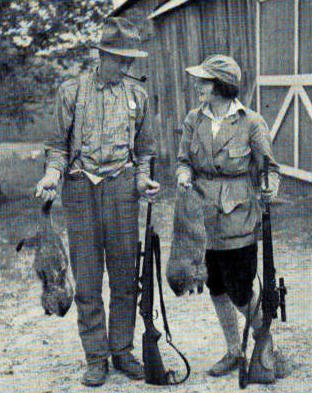

 The Accurate Reloading Forums
The Accurate Reloading Forums  THE ACCURATE RELOADING.COM FORUMS
THE ACCURATE RELOADING.COM FORUMS  Hunting
Hunting  Varmint Hunting
Varmint Hunting  Another Newbie Question - How to distinquish copper fouling?
Another Newbie Question - How to distinquish copper fouling?Go  | New  | Find  | Notify  | Tools  | Reply  |  |
| one of us |
Pardon another newbie question, but how does one distinguish copper fouling vs. regular powder residue in a relatively new factory factory (700VS) barrel. Thanks Mark | ||
|
| one of us |
A quick pass through the barrel with a light to moderate solvent will probably remove most of the powder residue. Then shine a hand held light into the first couple of inches of the muzzle and you will see the copper colored fouling on the rifling. Sweets 7.62 will remove that. The copper fouling will take more effort to remove then the powder residue. I have found that it is better to let the cleaner do the work, as opposed to trying to scrub it out with intensive brushing. This means letting the cleaner soak into the copper. Copper fouling will be a blue-green color liquid / gel on your cleaning patch. Powder residue will be black / grey crud on your patch. You should use care not to allow your cleaning rod to rub the bore as this can scar the bore. "Otis" sells a system of cables which you pull through the barrel. This eliminates the chance of scarring the bore. "Bore Guides" are also available for this feature. Ammonia is the primary ingredient for desolving contaminates in your barrel. So, the cleaners that stimulate your sinuses the most are the ones that do the most aggresive cleaning. Some people make an art out of cleaning their barrels, but thats a whole 'nother topic. "Seasoning a barrel" is a topic that will give you much insight as to the various cleaning methods. Hope that helped. Jake | |||
|
| one of us |
snipercountry As if that wasn't too much information, here is my favorite resource for all my gun cleaning questions. Prepair for various opinions and numberous techniques! Jake | |||
|
| one of us |
MDH1053-- Another suggestion to keep down fouling is proper break in . Probably as many methods as there are people posting here, I like to fire once than clean thoroughly for the first 9 or 10 rounds ( thats a ton of cleaning). Then clean after every 3 for the next 15. Make sure to get all powder and copper fouling out with each cleaning . This will smooth out the rough spots and while I admit it's a lot of work doing it the work it will save later is worth it big time. I would also invest in a bore guide to keep the rod centered and use a coated rod such as a Dewey. recoiljunky suggested Sweets which is one of my favorites and works extremely well on copper but I might further say it is suggested not to mix Sweets with other solvents, and don't use bronze brushes with it( it eats em and gives a false reading of copper. Also, don't soak the barrel in it for longer than 20 minutes it's quite harsh . It will come out bright blue with the copper but that will lessen as the copper is removed. A well broken in rifle is a pleasure to clean compared to one that isn't. I'm sure I made it sound confusing and it's really not and again I'm sure there's guys do it alot different , but that method has always worked well for me.---Shoot Safe---montdoug | |||
|
| one of us |
Using something like Sweets or CR10, powder fouling is black on the patch, copper fouling ends up blue/green. In the end though, the important thought to hang on to is that a rifle isn't fouled until the accuracy goes south. All else is twaddle. JMO, Dutch. | |||
|
| Powered by Social Strata |
| Please Wait. Your request is being processed... |
|
 The Accurate Reloading Forums
The Accurate Reloading Forums  THE ACCURATE RELOADING.COM FORUMS
THE ACCURATE RELOADING.COM FORUMS  Hunting
Hunting  Varmint Hunting
Varmint Hunting  Another Newbie Question - How to distinquish copper fouling?
Another Newbie Question - How to distinquish copper fouling?

Visit our on-line store for AR Memorabilia

